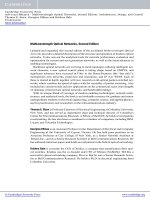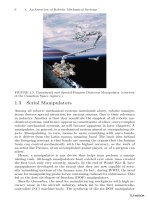Multiwavelength Optical Networks, Second Edition
Bạn đang xem bản rút gọn của tài liệu. Xem và tải ngay bản đầy đủ của tài liệu tại đây (322.73 KB, 30 trang )
Multiwavelength Optical Networks, Second Edition
Updated and expanded, this second edition of the acclaimed Multiwavelength Optical
Networks provides a detailed description of the structure and operation of modern optical
networks. It also sets out the analytical tools for network performance evaluation and
optimization for current and next generation networks, as well as the latest advances in
enabling technologies.
Backbone optical networks are evolving to mesh topologies utilizing intelligent net-
work elements; a new optical control plane is taking shape based on GMPLS; and
significant advances have occurred in Fiber to the Home/Premises (the “last mile”),
metropolitan area networks, protection and restoration, and IP over WDM. Each of
these is treated in depth, together with new research on all-optical packet-switched net-
works, which combine the speed of optics with the versatility of packet switching. Also
included are current trends and new applications on the commercial scene (wavelengths
on demand, virtual private optical networks, and bandwidth trading).
With its unique blend of coverage of modern enabling technologies, network archi-
tectures, and analytical tools, the book is an invaluable resource for graduate and senior
undergraduate students in electrical engineering, computer science, and applied physics,
and for practitioners and researchers in the telecommunications industry.
Thomas E. Stern is Professor Emeritus of Electrical Engineering at Columbia University,
New York, and has served as department chair and technical director of Columbia’s
Center for Telecommunications Research. A Fellow of the IEEE, he holds several patents
in networking. He has also been a consultant to a number of companies, including IBM,
Lucent, and Telcordia Technologies.
Georgios Ellinas is an Assistant Professor in the Department of Electrical and Computer
Engineering at the University of Cyprus, Nicosia. He has held prior positions as an
Associate Professor at City College of New York, as a Senior Network Architect at
Tellium Inc., and as a Senior Research Scientist at Bell Communications Research. He
has authored numerous papers and holds several patents in the field of optical networking.
Krishna Bala is currently the CEO of Xtellus, a company that manufactures fiber opti-
cal switches. Krishna was the co-founder and CTO of Tellium (NASDAQ: TELM), a
successful optical networking company. Prior to that he was a Senior Research Scien-
tist at Bell Communications Research. He holds a Ph.D. in electrical engineering from
Columbia University.
www.cambridge.org© Cambridge University Press
Cambridge University Press
978-0-521-88139-5 - Multiwavelength Optical Networks, Second Edition: Architectures, Design, and Control
Thomas E. Stern, Georgios Ellinas and Krishna Bala
Frontmatter
More information
Multiwavelength Optical
Networks, Second Edition
Architectures, Design, and Control
THOMAS E. STERN
Columbia University
GEORGIOS ELLINAS
University of Cyprus, Nicosia
KRISHNA BALA
Xtellus
www.cambridge.org© Cambridge University Press
Cambridge University Press
978-0-521-88139-5 - Multiwavelength Optical Networks, Second Edition: Architectures, Design, and Control
Thomas E. Stern, Georgios Ellinas and Krishna Bala
Frontmatter
More information
CAMBRIDGE UNIVERSITY PRESS
Cambridge, New York, Melbourne, Madrid, Cape Town, Singapore, S
˜
ao Paulo, Delhi
Cambridge University Press
32 Avenue of the Americas, New York, NY 10013-2473, USA
www.cambridge.org
Information on this title: www.cambridge.org/9780521881395
C
Cambridge University Press 2009
This publication is in copyright. Subject to statutory exception
and to the provisions of relevant collective licensing agreements,
no reproduction of any part may take place without the written
permission of Cambridge University Press.
First published 2009
Printed in the United States of America
A catalog record for this publication is available from the British Library.
Library of Congress Cataloging in Publication Data
Stern, Thomas E.
Multiwavelength optical networks : architectures, design and control / Thomas E. Stern,
Georgios Ellinas, Krishna Bala. – 2nd ed.
p. cm.
Includes bibliographical references and index.
ISBN 978-0-521-88139-5 (hbk.)
1. Optical communications. 2. Computer network architectures. I. Ellinas, Georgios.
II. Bala, Krishna. III. Title.
TK5103.59.S74 2009
621.382
7 – dc22 2008008319
ISBN 978-0-521-88139-5 hardback
Cambridge University Press has no responsibility for the persistence or
accuracy of URLs for external or third-party Internet Web sites referred to
in this publication and does not guarantee that any content on such Web
sites is, or will remain, accurate or appropriate. Information regarding
prices, travel timetables, and other factual information given in this work
are correct at the time of first printing, but Cambridge University Press
does not guarantee the accuracy of such information thereafter.
www.cambridge.org© Cambridge University Press
Cambridge University Press
978-0-521-88139-5 - Multiwavelength Optical Networks, Second Edition: Architectures, Design, and Control
Thomas E. Stern, Georgios Ellinas and Krishna Bala
Frontmatter
More information
To Monique, who has always been there for me. To our children and our grand-
children (T.E.S.)
To my loving mother, Mary, and sister, Dorita, and the memory of my beloved
father, Nicos (G.E.)
To my wife, Simrat, and our children, Tegh and Amrita (K.B.)
www.cambridge.org© Cambridge University Press
Cambridge University Press
978-0-521-88139-5 - Multiwavelength Optical Networks, Second Edition: Architectures, Design, and Control
Thomas E. Stern, Georgios Ellinas and Krishna Bala
Frontmatter
More information
Contents
Figures page xvii
Tables xxix
Preface to the Second Edition xxxi
Acknowledgments xxxv
1 The Big Picture 1
1.1 Why Optical Networks? 1
1.2 Objectives of an Optical Network Architecture 4
1.3 Optics versus Electronics: The Case for Transparent
Multiwavelength Networks 9
1.4 Optics and Electronics: The Case for Multilayered Networks 12
1.5 Network Hierarchies 16
1.6 A Little History 18
1.7 Overview and Road Map 22
2 The Layered Architecture and Its Resources 28
2.1 Layers and Sublayers 29
2.2 Network Links: Spectrum Partitioning 34
2.3 Optical Network Nodes: Routing, Switching, and Wavelength
Conversion 39
2.3.1 Static Nodes 40
2.3.2 Dynamic Nodes 46
2.3.3 Wavelength Converters 63
2.4 Network Access Stations 67
2.4.1 Transmitting Side 70
2.4.2 Receiving Side 71
2.5 Overlay Processors 74
2.5.1 Regeneration 76
2.5.2 Wavelength Interchange 76
2.6 Logical Network Overlays 77
2.6.1 SONET Networks 79
2.6.2 ATM Networks 81
www.cambridge.org© Cambridge University Press
Cambridge University Press
978-0-521-88139-5 - Multiwavelength Optical Networks, Second Edition: Architectures, Design, and Control
Thomas E. Stern, Georgios Ellinas and Krishna Bala
Frontmatter
More information
viii Contents
2.6.3 IP Networks 83
2.6.4 MPLS and Its Extensions 84
2.7 Summary 85
2.8 Problems 87
3 Network Connections 91
3.1 Connection Management and Control 96
3.1.1 Optical Connections 100
3.1.2 Logical Connections 100
3.2 Static Networks 102
3.2.1 Point-to-Point and Multipoint Connections 104
3.2.2 Packet Switching in the Optical Layer: The MAC Sublayer 111
3.2.3 Additional Comments on Broadcast-and-Select 121
3.3 Wavelength-Routed Networks 122
3.3.1 Routing and Channel Assignment 124
3.3.2 Routing and Channel Assignment Examples 128
3.4 Linear Lightwave Networks: Waveband Routing 133
3.4.1 Routing and Channel Assignment 135
3.4.2 Multipoint Subnets in LLNs 140
3.4.3 A Seven-Station Example 143
3.5 Logically-Routed Networks 151
3.5.1 Point-to-Point Logical Topologies 153
3.5.2 Multipoint Logical Topologies: Hypernets 156
3.6 Summary 162
3.7 Problems 163
4 Enabling Technology 165
4.1 Evolution of Transmission and Switching Technology 166
4.2 Overview of the Optical Connection 167
4.3 Optical Fibers 168
4.3.1 Principles of Guided-Wave Propagation 168
4.3.2 Optical Fiber Technology: Transmission Impairments 174
4.3.3 Solitons 187
4.3.4 Photonic Crystal Fibers 188
4.4 Amplifiers 190
4.4.1 Erbium-Doped Fiber Amplifiers 191
4.4.2 Raman Amplifiers 198
4.4.3 Semiconductor Optical Amplifiers 201
4.4.4 Amplification Trends in Metro Optical Networks: Amplets 204
4.5 Optical Transmitters 205
4.5.1 Lasers 205
4.5.2 Vertical Cavity Surface Emitting Lasers 211
4.5.3 Modulation Technology 212
www.cambridge.org© Cambridge University Press
Cambridge University Press
978-0-521-88139-5 - Multiwavelength Optical Networks, Second Edition: Architectures, Design, and Control
Thomas E. Stern, Georgios Ellinas and Krishna Bala
Frontmatter
More information
Contents ix
4.6 Optical Receivers in Intensity-Modulated Direct-Detection
Systems 217
4.6.1 Photodetectors 217
4.6.2 Front-End Amplifier: Signal-to-Noise Ratio 219
4.6.3 Digital Signal Detection: Noise, Interference, and Bit
Error Rate 221
4.6.4 Analog Systems: Carrier-to-Noise Ratio 227
4.7 The End-to-End Transmission Channel 228
4.7.1 Modulation Formats 229
4.7.2 Forward Error Correction 231
4.7.3 Equalization 233
4.8 Coherent Optical Systems 234
4.9 Performance Impairments in a Network Environment 235
4.9.1 Cross-Talk 235
4.9.2 Signal Power Divergence 239
4.9.3 Chirp-Induced Penalty 240
4.9.4 Optical Filter Concatenation: Distortion-Induced Penalty 240
4.9.5 Polarization Mode Dispersion Impact on
System Performance 241
4.10 Optical and Photonic Device Technology 241
4.10.1 Couplers and Switches 242
4.10.2 Reciprocity 255
4.10.3 Nonreciprocal Devices 257
4.10.4 Optical Filtering Technology 257
4.10.5 Multiwavelength Switch Technology 266
4.11 Wavelength Conversion and Signal Regeneration 274
4.11.1 All-Optical Wavelength Conversion 275
4.11.2 Opaque Wavelength Conversion and Signal Regeneration 278
4.12 Optical Switch Architectures 281
4.12.1 Space Switches 281
4.12.2 Wavelength-Selective Switches 288
4.13 Performance Evaluation: Methodology and Case Studies 297
4.13.1 Physical-Layer Simulation: Three-Step Approach 298
4.13.2 WDM Network Simulation Case Studies 301
4.14 Problems 311
5 Static Multipoint Networks 324
5.1 Shared Media: The Broadcast Star 324
5.2 Representative Multiplexing and Multiple-Access Schemes 327
5.2.1 Time-Wavelength-Division Multiplexing/Multiple
Access 328
5.2.2 Subcarriers 336
5.2.3 Code Division Multiple Access 352
www.cambridge.org© Cambridge University Press
Cambridge University Press
978-0-521-88139-5 - Multiwavelength Optical Networks, Second Edition: Architectures, Design, and Control
Thomas E. Stern, Georgios Ellinas and Krishna Bala
Frontmatter
More information
x Contents
5.3 Traffic Constraints in Shared-Channel Networks 367
5.3.1 Balanced Traffic 370
5.3.2 Unbalanced Traffic 370
5.4 Capacity Allocation for Dedicated Connections 371
5.4.1 Fixed-Frame Scheduling for Stream Traffic 371
5.4.2 Fixed-Frame Scheduling for Packet Traffic 383
5.5 Demand-Assigned Connections 389
5.5.1 Blocking Calculations in WDMA Networks 390
5.5.2 Blocking in Combined Time-Wavelength-Division
Networks 395
5.6 Packet Switching in the Optical Layer 399
5.6.1 Uncontrolled Scheduling: Random Access 401
5.6.2 Scheduling with Loss 403
5.6.3 Lossless Scheduling: Reservations 405
5.6.4 Perfect Scheduling 407
5.6.5 Dynamic versus Fixed Capacity Allocation 408
5.7 The Passive Optical Network 409
5.7.1 ATM and Fixed-Frame PONs 412
5.7.2 Ethernet-Based PONs 414
5.7.3 WDM PONs 416
5.7.4 Optical-Wireless Access 420
5.7.5 Recent Trends 422
5.8 Summary 424
5.9 Problems 425
6 Wavelength/Waveband-Routed Networks 432
6.1 Introduction 432
6.2 Physical Topologies 434
6.3 Wavelength-Routed Networks: Static Routing
and Channel Assignment 442
6.3.1 Flow Bounds: Matching the Physical
and Logical Topologies 444
6.3.2 Nonblocking Stations 448
6.3.3 RCA as a Graph Coloring Problem 449
6.3.4 Rings 452
6.3.5 Ring Decomposition of General Mesh Networks 458
6.3.6 Multistar Wavelength-Routed Networks 462
6.3.7 RCA as an Optimization Problem 464
6.3.8 Heuristics for Static RCA 474
6.4 Wavelength-Routed Networks: Dynamic Routing
and Channel Assignment 484
6.4.1 Some Basic Routing and Channel Assignment Algorithms 484
www.cambridge.org© Cambridge University Press
Cambridge University Press
978-0-521-88139-5 - Multiwavelength Optical Networks, Second Edition: Architectures, Design, and Control
Thomas E. Stern, Georgios Ellinas and Krishna Bala
Frontmatter
More information
Contents xi
6.4.2 Case Study: Bidirectional Rings 491
6.4.3 Performance of Dynamic Routing Rules on Meshes 494
6.4.4 Case Study: An Interconnected Ring 495
6.4.5 Routing Multicast Connections in WRNs 497
6.5 Linear Lightwave Networks: Static Routing Rules 507
6.5.1 Routing of Optical Paths 509
6.5.2 Optical Connections: λ-Channel Assignment 516
6.5.3 Significance of Nonblocking Access Stations in LLNs 518
6.5.4 Local Access to LLNs 519
6.5.5 Routing Waveband and Channel Assignment on the
Petersen Network 521
6.5.6 Channel Assignment 528
6.5.7 Multistar Linear Lightwave Networks 540
6.6 Linear Lightwave Networks: Dynamic Routing Rules 544
6.6.1 Point-to-Point Connections 544
6.6.2 Routing Multicast Connections in LLNs 558
6.7 Problems 568
7 Logically-Routed Networks 576
7.1 Introduction: Why Logically-Routed Networks? 576
7.1.1 Multitier Networks: Grooming 581
7.2 Point-to-Point Logical Topologies: Multihop Networks 585
7.2.1 ShuffleNets 587
7.2.2 Families of Dense Logical Topologies 589
7.3 Multihop Network Design 591
7.3.1 Logical-Layer Design 591
7.3.2 Physical-Layer Design 594
7.3.3 Traffic Grooming in Point-to-Point
Logical Topologies 597
7.4 Multipoint Logical Topologies: Hypernets 607
7.4.1 Capacity of a Multipoint Subnet 611
7.4.2 Families of Dense Hypernets 613
7.4.3 Kautz Hypernets 615
7.4.4 Hypernet versus Multihop 628
7.4.5 Multicast Virtual Connections 631
7.5 Hypernet Design 632
7.5.1 Logical-Layer Design 632
7.5.2 Physical-Layer Design 634
7.5.3 Traffic Grooming in Multipoint Logical
Topologies 637
7.5.4 Multistar Realizations 639
7.6 Summary 641
7.7 Problems 642
www.cambridge.org© Cambridge University Press
Cambridge University Press
978-0-521-88139-5 - Multiwavelength Optical Networks, Second Edition: Architectures, Design, and Control
Thomas E. Stern, Georgios Ellinas and Krishna Bala
Frontmatter
More information
xii Contents
8 Survivability: Protection and Restoration 647
8.1 Objectives of Protection and Restoration 648
8.2 Current Fault Protection and Restoration Techniques in
the Logical Layer 650
8.2.1 Point-to-Point Systems 650
8.2.2 SONET Self-Healing Rings 654
8.2.3 SONET Self-Healing Ring Interconnection Techniques 657
8.2.4 Architectures with Arbitrary Mesh Topologies 663
8.3 Optical-Layer Protection: Point-to-Point and Ring Architectures 669
8.3.1 Point-to-Point Systems 669
8.3.2 Self-Healing Optical Rings 672
8.4 Optical-Layer Protection: Mesh Architectures 677
8.4.1 Shared Optical Layer Line-Based Protection 679
8.4.2 Optical Path-Based Protection 692
8.4.3 Segment Protection 700
8.4.4 Survivability Techniques for Multicast Connections 702
8.5 Summary 703
8.6 Problems 706
9 Optical Control Plane 714
9.1 Introduction to the Optical Control Plane 716
9.1.1 Control-Plane Architecture 719
9.1.2 Control-Plane Interfaces 719
9.1.3 Control-Plane Functions 721
9.2 Overview of Multiprotocol Label Switching 722
9.2.1 Packet Transport through an MPLS Network 722
9.2.2 MPLS Protocol Stack 727
9.2.3 MPLS Applications 728
9.3 Overview of Generalized Multiprotocol Label Switching 729
9.3.1 Link Management in GMPLS 731
9.3.2 Routing in GMPLS 734
9.3.3 Signaling in GMPLS 742
9.4 Conclusions 751
10 Optical Packet-Switched Networks 756
10.1 Optical Packet-Switched Network Architectures 758
10.1.1 Unbuffered Networks 759
10.1.2 Deflection Routing 764
10.1.3 Performance Analysis of Deflection Routing 766
10.1.4 Buffering: Time Domain Contention Resolution 770
10.1.5 Buffering and Wavelength Conversion: Time/Wavelength
Domain Contention Resolution 778
www.cambridge.org© Cambridge University Press
Cambridge University Press
978-0-521-88139-5 - Multiwavelength Optical Networks, Second Edition: Architectures, Design, and Control
Thomas E. Stern, Georgios Ellinas and Krishna Bala
Frontmatter
More information
Contents xiii
10.1.6 Comparison of Contention Resolution Techniques for
Asynchronous OPS Networks 782
10.1.7 Hybrid Electronic and Optical Buffering 784
10.2 OPS Enabling Technologies 787
10.2.1 Packet Synchronization 788
10.2.2 All-Optical 2R or 3R Regeneration 788
10.2.3 Optical Switching 788
10.2.4 Wavelength Conversion 789
10.2.5 Optical Header Processing 789
10.2.6 Optical Buffering 789
10.3 OPS Network Testbed Implementations 791
10.3.1 CORD Testbed 791
10.3.2 KEOPS Testbed 793
10.3.3 WASPNET Testbed 796
10.4 Optical Burst Switching 798
10.4.1 Just Enough Time Protocol 801
10.4.2 Just In Time Protocol 803
10.4.3 Contention Resolution in OBS Networks 806
10.5 Optical Label Switching 808
10.5.1 All-Optical Label Swapping 809
10.5.2 Contention Resolution Techniques 811
10.5.3 OLS Network Implementations 811
10.6 Conclusions 820
10.7 Problems 822
11 Current Trends in Multiwavelength Optical Networking 828
11.1 Business Drivers and Economics 828
11.1.1 Cost Issues for WDM Point-to-Point Systems 831
11.1.2 Cost Issues for WDM Rings 832
11.1.3 Cost Issues for WDM Cross-Connect Networks 833
11.1.4 Open versus Closed WDM Installations 835
11.2 Multiwavelength Optical Network Testbeds 838
11.2.1 Optical Networks Technology Consortium 838
11.2.2 All-Optical Network Consortium 839
11.2.3 European Multiwavelength Optical Network Trials 839
11.2.4 Multiwavelength Optical Network 840
11.2.5 National Transparent Optical Networks Consortium 840
11.2.6 The Importance of the Testbeds in Driving the
Telecommunications Infrastructure 840
11.3 Metropolitan Area Networks 841
11.3.1 Metro Network Unique Characteristics 841
11.3.2 Defining the Metropolitan Networking Domain 842
www.cambridge.org© Cambridge University Press
Cambridge University Press
978-0-521-88139-5 - Multiwavelength Optical Networks, Second Edition: Architectures, Design, and Control
Thomas E. Stern, Georgios Ellinas and Krishna Bala
Frontmatter
More information
xiv Contents
11.3.3 Metro Network Evolution 844
11.3.4 Metro Networking State of the Art 847
11.4 Long-Haul and Ultra Long-Haul Networks 854
11.4.1 Current Considerations in Wide Area
Network Architectures 854
11.4.2 Some Recent Commercial Network Deployments 856
11.5 New Applications and Services 858
11.5.1 Wavelength-on-Demand 858
11.5.2 Virtual Private Optical Networks 858
11.5.3 Bandwidth Trading 859
11.6 Conclusions 861
A Graph Theory 869
A.1 Graphs 869
A.1.1 Cycle Double Covers 872
A.1.2 Eulerian Graphs 872
A.1.3 Planar Graphs 873
A.1.4 Matchings in Graphs 873
A.1.5 Graph Coloring 874
A.1.6 Digraphs 875
A.1.7 Moore Bounds 875
A.1.8 Max Flow–Min Cut 876
A.2 Hypergraphs 877
A.2.1 Undirected Hypergraphs 877
A.2.2 Directed Hypergraphs 878
B Fixed Scheduling Algorithm 879
B.1 Column/Row–Expansion Algorithm 880
B.2 Decomposition into Permutation Matrices 883
B.3 Column/Row–Compression Algorithm 883
C Markov Chains and Queues 884
C.1 Random Processes 884
C.2 Markov Processes 885
C.3 Queues 887
C.3.1 The M |M |1 Queue 888
C.3.2 The M |G |1 Queue 888
C.3.3 Little’s Formula 889
www.cambridge.org© Cambridge University Press
Cambridge University Press
978-0-521-88139-5 - Multiwavelength Optical Networks, Second Edition: Architectures, Design, and Control
Thomas E. Stern, Georgios Ellinas and Krishna Bala
Frontmatter
More information









